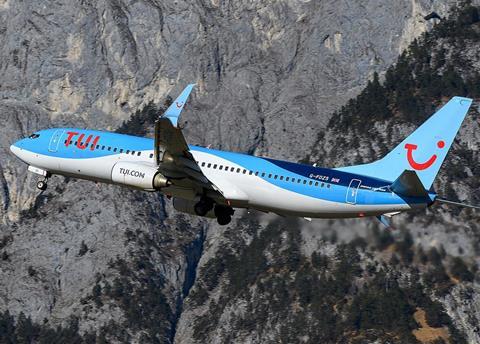UK investigators have disclosed that a Boeing 737-800 crew manually selected insufficient thrust after the autothrottle disengaged during take-off from Bristol, resulting in the jet’s belatedly becoming airborne and overflying a major road at less than 100ft.
The TUI Airways aircraft, bound for Gran Canaria on 4 March, was departing from Bristol’s runway 09.
According to the Air Accidents Investigation Branch, the flying pilot advanced the thrust levers to 40% of N1, paused to allow the engines to spool up and stabilise, then pressed the take-off/go-around switch which engages the autothrottle.
But the autothrottle disengaged, says a preliminary bulletin on the incident, apparently due to a known susceptibility of older autothrottle servo motors. Certain power-on or power-transfer events, it says, can cause the servo motor to shut down internally and cause an autothrottle disconnect.
The bulletin says the autothrottle has a “long history of nuisance disconnects” when engaged during take-off. While a more robust servo motor has been developed, the TUI 737 still had the older version fitted.

When the autothrottle disengaged, the monitoring pilot immediately re-armed it, while the flying pilot advanced the thrust levers towards the required take-off setting before relinquishing control of them.
But the autothrottle, after being re-armed, did not control the thrust-lever servos as the pilots expected.
“As a result, the thrust levers did not advance to the required thrust setting and neither pilot moved them from the position the [flying pilot] had set them to,” says the bulletin.
Although standard procedures require thrust to be set by 60kt, and checked at 80kt, neither pilot noticed the incorrect thrust setting.
The 737 accelerated with “significantly less” thrust than needed – around 84.5% of N1, rather than 92.8% – and eventually rotated just 260m from the end of the runway.
It crossed the runway end at a height of just 10ft and overflew the north-south A38 boundary road, some 400m beyond, at less than 100ft.
Both pilots had noticed how close the runway end had been, and the aircraft’s thrust setting was increased at 450ft, although the required take-off thrust was not achieved until passing 900ft, according to flight-data recorder information.
The cockpit-voice recorder was overwritten during the flight to Gran Canaria’s Las Palmas airport which, says the bulletin, was uneventful apart from several attempts to re-engage the autothrottle.
None of the 163 passengers and six crew members on board the 15-year old aircraft (G-FDZS) was injured. Investigators are still probing the incident and have yet to issue final conclusions.





























